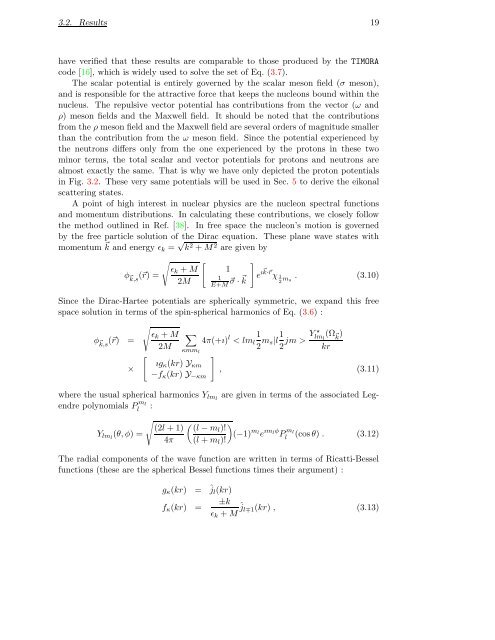Download Thesis in Pdf Format - Theoretical Nuclear Physics and ...
Download Thesis in Pdf Format - Theoretical Nuclear Physics and ...
Download Thesis in Pdf Format - Theoretical Nuclear Physics and ...
You also want an ePaper? Increase the reach of your titles
YUMPU automatically turns print PDFs into web optimized ePapers that Google loves.
3.2. Results 19<br />
have verified that these results are comparable to those produced by the TIMORA<br />
code [16], which is widely used to solve the set of Eq. (3.7).<br />
The scalar potential is entirely governed by the scalar meson field (σ meson),<br />
<strong>and</strong> is responsible for the attractive force that keeps the nucleons bound with<strong>in</strong> the<br />
nucleus. The repulsive vector potential has contributions from the vector (ω <strong>and</strong><br />
ρ) meson fields <strong>and</strong> the Maxwell field. It should be noted that the contributions<br />
from the ρ meson field <strong>and</strong> the Maxwell field are several orders of magnitude smaller<br />
than the contribution from the ω meson field. S<strong>in</strong>ce the potential experienced by<br />
the neutrons differs only from the one experienced by the protons <strong>in</strong> these two<br />
m<strong>in</strong>or terms, the total scalar <strong>and</strong> vector potentials for protons <strong>and</strong> neutrons are<br />
almost exactly the same. That is why we have only depicted the proton potentials<br />
<strong>in</strong> Fig. 3.2. These very same potentials will be used <strong>in</strong> Sec. 5 to derive the eikonal<br />
scatter<strong>in</strong>g states.<br />
A po<strong>in</strong>t of high <strong>in</strong>terest <strong>in</strong> nuclear physics are the nucleon spectral functions<br />
<strong>and</strong> momentum distributions. In calculat<strong>in</strong>g these contributions, we closely follow<br />
the method outl<strong>in</strong>ed <strong>in</strong> Ref. [38]. In free space the nucleon’s motion is governed<br />
by the free particle solution of the Dirac equation. These plane wave states with<br />
momentum ⃗ k <strong>and</strong> energy ɛ k = √ k 2 + M 2 are given by<br />
φ ⃗k,s (⃗r) =<br />
√ [<br />
ɛ k + M<br />
2M<br />
1<br />
E+M<br />
]<br />
1<br />
⃗σ · ⃗k<br />
e ı⃗k·⃗r χ 1 . (3.10)<br />
ms<br />
2<br />
S<strong>in</strong>ce the Dirac-Hartee potentials are spherically symmetric, we exp<strong>and</strong> this free<br />
space solution <strong>in</strong> terms of the sp<strong>in</strong>-spherical harmonics of Eq. (3.6) :<br />
φ ⃗k,s (⃗r) =<br />
×<br />
√<br />
ɛ k + M ∑<br />
4π(+ı) l 1<br />
< lm l<br />
2M<br />
κmm l<br />
2 m s|l 1 2 jm > Y lm ⋆<br />
l<br />
(Ω ⃗k )<br />
kr<br />
[ ]<br />
ıgκ (kr) Y κm<br />
, (3.11)<br />
−f κ (kr) Y −κm<br />
where the usual spherical harmonics Y lml are given <strong>in</strong> terms of the associated Legendre<br />
polynomials P m l<br />
l<br />
:<br />
√ ( )<br />
(2l + 1) (l − ml )!<br />
Y lml (θ, φ) =<br />
(−1) m l<br />
e ımlφ P m l<br />
l<br />
(cos θ) . (3.12)<br />
4π (l + m l )!<br />
The radial components of the wave function are written <strong>in</strong> terms of Ricatti-Bessel<br />
functions (these are the spherical Bessel functions times their argument) :<br />
g κ (kr) = ĵ l (kr)<br />
f κ (kr) =<br />
±k<br />
ɛ k + M ĵl∓1(kr) , (3.13)















